

Cigarette brands from the 1960s - USA
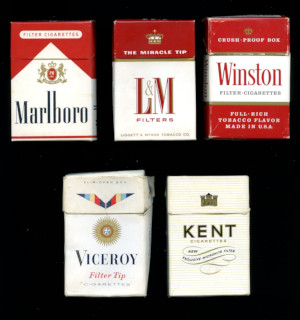
Per capita cigarette consumption peaked in 1963. The following year, Luther L Terry, the Surgeon General, published a report linking smoking and cancer. Many Americans thought again about smoking. However, in 1968 there were over 100 different American cigarette brands.
The cigarette market changed in the 1960s. There was a fragmentation into different sectors: regular cigarettes, filter cigarettes, menthol cigarettes, charcoal-filter cigarettes and low-tar cigarettes. Each corresponded to a different attitude a smoker might have to the risk of smoking.
Most people were aware of the dangers of cigarette smoking through articles in Readers' Digest and Consumer Reports. Some gave up, others modified their smoking habits, choosing different brands or by trying to cut down.
In 1966 the US Government introduced a health warning that appeared on every packet sold in the USA:
'Caution: Cigarette Smoking May be Hazardous to Your Health.'
The government strengthened this warning in 1969 to:
'Warning: The Surgeon General Has Determined That Cigarette Smoking is Dangerous to Your Health'. This warning did not appear on packs until 1970.
The health risks did not stop the US Military giving a cigarette ration to soldiers fighting in Vietnam. [1]
The big trend of the decade was not a mass rejection of smoking but an increase in the sales of filter cigarettes at the expense of plain. In 1960 53% of cigarettes sold had a filter. By 1969 the figure was 77%.
The two best-selling filter brands were Winston (R J Reynolds) and Marlboro (Philip Morris). The top selling regular (unfiltered) cigarettes were Pall Mall and Camel. They still sold but with a decreased market share.
Giving up cigarettes was hard and the filters offered reassurance to those who choose to continue. It was false reassurance.
Some knowledge at the time pointed to this. A study by the Roswell Park Memorial Institute, New York's cancer research and treatment centre, showed that some filter brands were worse in terms of tar and nicotine than plain versions of the same cigarette. The Pall Mall filter tip, introduced in 1964, passed more tar and nicotine than regular Pall Mall. [2]
The Consumer's Union was even clearer in a report of 1964 on the low-tar cigarette, Carlton. Even low-tar cigarettes were not safe. Their advice to smokers was give up, or switch to a pipe or cigars.
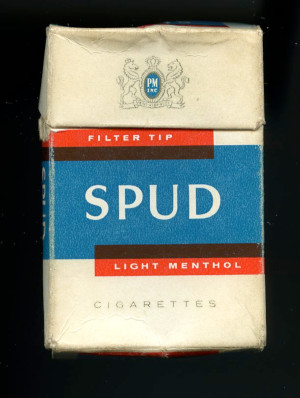
Committed smokers clung to every straw. There was an increase in popularity of menthol-flavoured cigarettes. People associated them with being healthier. Menthol flavouring had no impact on the tar or nicotine content of the cigarette.
The other trends were the rise of charcoal filters, of low-tar cigarettes and at the other extreme, of extra long cigarettes.
Tareyton was the first and best-selling charcoal filter cigarette. Their adverts had some humor, suggesting smokers of other brands should attach the Tareyton filter to their cigarette.
Extra-long cigarettes came in the second half of the 1960s. They were a response to rising affluence rather than health concerns. Long and slim cigarettes were targeted at women smokers. Slim being a suggestion, never directly made, that smoking might help with weight loss.
New brands were backed by huge advertising campaigns. Historic brands such as Camel, Lucky Strike and Chesterfield were allowed to wither.
In 1960 the best-selling cigarette brands were:
- Pall Mall (king-size, plain) - 14.0%
- Camel (plain) - 13.9%
- Winston (filter) - 11.0%
- Lucky Strike (plain) - 8.9%
- Kent (filter) - 8.0%
- Salem (menthol) - 7.4%
- L & M (filter) - 5.2%
- Marlboro (filter) - 4.6%
- Viceroy (filter) - 4.5%
- Kool (menthol, plain) - 3.1%
- Chesterfield (plain) - 3.1%
- Chesterfield (king-size, plain) - 2.6%
Source: The National Archives Federal Register of the United States, published July 1, 1964, page 8337
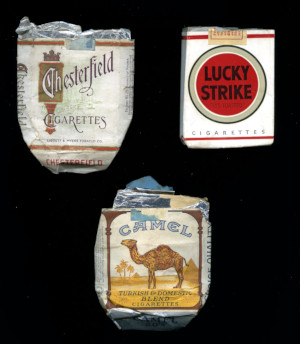
Pall Mall was an old brand, launched in 1899 by the UK company, Black Butler. Pall Mall is an expensive street in London; it is home to some of London's famous gentleman's clubs.
British American Tabacco (BAT) bought the brand in 1907. They relaunched Pall Mall in 1939 as the first king-size cigarette, 85mm length. [3]
Unlike masculine brands such as Camel and Marlboro, Pall Mall had unisex appeal. In the 1960s, BAT advertised Pall Mall in Life Magazine, Popular Science and Ebony. The targeted both male and female smokers.
Camel, at number two, was also a brand with history. It dated from 1913.
Winston at number three was a new filter cigarette introduced in the 1950s. Winston delivered nearly as much tar and nicotine as Camel and Lucky Strike. The name has nothing to do with Britain's wartime leader Winston Churchill, but with Winston-Salem, North Carolina where the Winston's maker R J Reynolds was based.
By 1969 the picture had changed:
- Winston (filter) - 12.9%
- Pall Mall (king-size, plain) - 9.6%
- Marlboro (filter) - 7.6%
- Salem (menthol) - 6.9%
- Camel (plain) - 6.2%
- Kool (menthol filter) - 5.8%
- Kent (filter) - 4.7%
- Lucky Strike (plain) - 3.5%
- Viceroy (filter) - 3.3%
- Tareyton (filter) - 3.1%
Source: How the brands ranked by Maxwell International Estimates, published June 1972
Filter cigarettes dominated the market by the end of the 1960s. Philip Morris's relaunch of Marlboro in the 1950s was paying off. Leo Burnett's cowboy adverts for Marlboro were some of the most compelling of the era. Marlboro's market share rose from 4.6% to 7.6% over the 1960s.
Surpisingly the best selling low-tar brand, Kent, declined in market share from 8.0% to 4.7%.
Several new brands were launched in the 1960s. Nearly all new cigarettes had filters. Few made much of an impact.
- Lark (1963)
- Carlton (1964)
- Paxton Menthol (1963)
- Philip Morris Multifilter (1964)
- LS Filter (1964)
- Half & Half (1964)
- Pall Mall Filter Kings (1964)
- Tempo (1964)
- Galaxy (1965)
- Camel Filter (1966)
- Chesterfield Filter (1966)
- True (1966)
- Doral (1969)
Also new in the 1960s were filter versions of historic brands such as Pall Mall, Camel and Chesterfield.
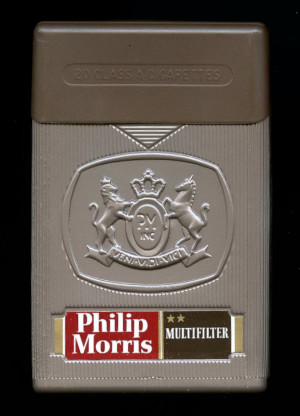
Charcoal filters
A trend that grew in the 1960s was the charcoal or activated charcoal filter. They were often called 'dual filters' as there was another filter between the charcoal filter and the end of the cigarette. It sounded scientific and scientific-looking diagrams were often shown in the adverts. No-one said exactly what the charcoal was meant to remove. Most adverts touted an improvement in taste.
Charcoal filters caught on with some customers. The jury is still out as to whether charcoal filters had any real benefit. By the end of the decade 6% of cigarettes sold in the USA had a charcoal filter.
Tareyton was the first and dated back to 1954. It remained the most popular in this sector by a wide margin.
Lark was the more successful of the new brands. It was America's eighteen favorite cigarette in 1967 and 1968.
By 1968 these cigarettes had a charcoal filter:
| Brand | Market share |
|---|---|
| Tareyton | 3.1% |
| Lark | 1.4% |
| Tareyton 100 | 0.4% |
| Philip Morris Multifilter | 0.4% |
| Carlton | 0.2% |
| Tempo | 0.1% |
| King Sano | 0.1% |
| Lark 100 | 0.1% |
| Galaxy | 0.1% |
Plastic packs
Philip Morris Multifilter had an innovative plastic pack.
Philip Morris first used this pack for Paxton Menthol in 1963. The pack, called a 'Humiflex', was designed by Walter Landor a German immigrant. Landor's box was ivory with a turquoise or green pull-off lid. The advert suggested it was waterproof. [4]
In 1964, Philip Morris launched Multifilter with a charcoal filter in both Europe and America. The Multifilter filter was made from coconut shell heated to a high temperature. The adverts talked about its special properties without saying what it was meant to do.
The pack was Landor's plastic pack. The Multifilter version was two shades of brown.
Around 1968 Philip Morris improved to give it a flip-top lid.
Neither the pack, nor the filter inspired. Multifilter only achieved a modest market share in America. It was ranked number 30 in 1967. [5]
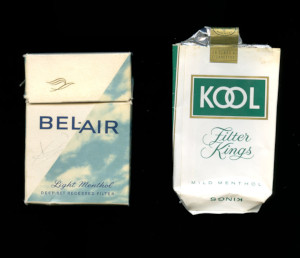
Menthol-flavored cigarettes
Menthol cigarettes were not invented in the 1960s. Spud, the first dates to 1924 and Kool to 1933. Their popularity increased in the second half of the 1950s. In 1960 menthol cigarettes took 12% of the total market. By 1970 it was 17%.
Salem and Kool were the leading brands from this era. There were some strange adverts suggesting the freshness of menthol cigarettes.
Menthol brands from 1960 included.
- Alpine
- Belair
- Frappe
- King Sand
- Kool
- Oasis
- Mayfield
- Newport
- Riviera
- Salem
- Spring
- Spud
Source: Cigarettes, a report published in Consumer Reports January 1960, pages 20 and 21
The menthol flavor made the cigarettes taste less harsh and may have had a vague health benefit in the eyes of customers.
Menthol cigarettes offered no intrinsic health benefit. Spud had low-tar and nicotine but Kool and Belair contained more tar than regular Camels according to the Consumer Reports data published in 1960.
100mm cigarettes
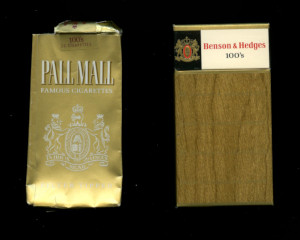
The biggest change in the 1960s cigarette market was the introduction of larger than king-size, 100mm cigarettes. By 1969 this category was 15% of the US market, including menthol flavored cigarettes. These new brands were launched in the 1960s.
- Winston 100s (1967) (*)
- Benson & Hedges 100s (1966) (*)
- Pall Mall 100s (1965) (*)
- Marlboro 100s (1967)
- Kent 100s (1967)
- Tareyton 100s (1967)
- Virginia Slims (1968) (*)
- Silva Thins (1967)
- Viceroy 100s (1967)
- Raleigh 100s (1969)
- Parliament 100s (1968)
- L & M 100s (1967) (*)
- Lark 100s (1968)
- Old Gold Filters 100s
- Chesterfield 101s (1967)
- Lucky Strike 100s (1968)
- Kool 100s (menthol) (1967)
- Salem 100s (menthol) (1967)
- Newport 100s (menthol) (1968)
- Spring 100s (menthol) (1966
(*) Menthol version also launched
Source: Estimated domestic cigarette consumption by brand and category, downloaded from Truth Tobacco Industry Documents
Two of the first brands to launch this type of cigarette were Pall Mall and Benson & Hedges. Both achieved strong sales in the second half of the 1960s but fell outside of the top ten. Competition came from other brands such as Winston 100mm which overtook both these brands by the end of the 1960s.
Thin 100mm cigarettes
A further development of the 100mm market was thin cigarettes.
Philip Morris launched Virgina Slims in 1968. They targeted women smokers. Their advertising stressed freedom and liberation from earlier restrictions on women's smoking. Now women had the freedom to smoke and their own cigarettes!
American Tobacco launched Silva Thins, also in 1968. Their black and white advertising and packaging was stylish and sophisticated. The branding was more androgynous than Virginia Slims. Both men and women featured in the adverts. A man wearing dark sunglasses was a consistent theme. American Tobacco claimed that Silva Thins were lower in tar and nicotine than rivals but tasted better.
Low-tar cigarettes
Low-tar cigarettes appealed to worried smokers unable give up. The presence of the low-tar and low-nicotine brands may have encouraged more people to keep smoking when they would otherwise have quit. Tests run by consumer and health bodies compared tar and nicotine levels of brands and highlighted those with the lowest levels, sometimes giving an unwitting sales boost to some brands.
The Consumers' Union had already decided low-tar cigarettes were of little benefit in 1964. However, the Federal Trade Commission published a list of cigarette brands by tar and nicotine content from 1967.
A significant new brand launched in 1966 was Lorillard's True. True used an air filtration system which was thought to be more effective. A test by the Roswell Park Memorial Institute showed the filter was indeed effective. [2] Although, 50% of the tar of a regular cigarette was still present in what the smoker inhaled. At its launch True achieved 1.7% of the US cigarette market. However, its market share declined subsequently. In the 1970s Lorillard pushed True as a last resort for smokers not wanting to give up. It did not achieve much more than a 1% market share.
It may seem logical that lower tar and nicotine cigarettes would reduce the risk of lung cancer, they were not as effective as people hoped for in the 1960s. Smokers found ways of still getting their fix out of low-tar cigarettes by drawing harder and smoking down to the butt. Smokers found that they got through more low-tar cigarettes than regular ones.
The lowest tar cigarettes in 1960 were:
- Duke of Durham - king-size filter
- Spud - menthol filter
- Life - king-size filter
- Spring - menthol filter
- Kent - regular and long filter
- Benson & Hedges
Source: Cigarettes, a report published in Consumer Reports January 1960, pages 20 and 21
James Bond chose Duke of Durham when he tried to improve his health in Thunderball (1961), after having read the article in Consumer Reports.
From this list only Kent featured in the top ten cigarette brands.
New entrants to this market in the 1960s were:
- Carlton - 1964
- True - 1966
- Doral - 1969
By Steven Braggs, September 2023
References
[1] 'Tobacco' by Iain Gately, published by Grove Press, 2001, page 302
[2] 'Several filter tips found ineffective' by Jane E Brody, published in the New York Times, August 30, New York Times, page 1
[3] Trust in Tobacco by Maurice Corina, published in 1975 by Michael Joeseph, page 237
[4] See Paxton Cigarette Box at the National Museum of American History
[5] 'The Maxwell Report 1968' published in the Tobacco Reporter, November 1968, volume 95, number 11.
Read more:
Cigarette brands in the 1950s - USA
Cigarette brands in the 1970s - USA
Cigarette smoking in the 1950s - USA
Cigarette brands in the 1960s - UK


Comments